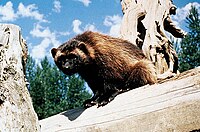Wolverine
| Wolverine | |
|---|---|

| |
| Scientific classification | |
| Kingdom: | |
| Phylum: | |
| Class: | |
| Order: | |
| Family: | |
| Genus: | Gulo |
| Species: | G. gulo
|
| Binomial name | |
| Gulo gulo | |
The Wolverine (Gulo gulo) is the largest land-dwelling species of the Mustelidae or weasel family (the sea otter is largest overall); and is the only species currently classified in the genus Gulo (meaning "glutton"). It is also called the Glutton or Carcajou. Three subspecies are recognized by some authors: the Old World form Gulo gulo gulo and the New World forms G. g. luscus and G. g. vancouverensis.
Anatomy
The Wolverine is a stocky and muscular animal, considered carnivorous but known on occasion to eat plant material. It has glossy brown hair with stripes of yellow along the sides. The fur is long and dense and does not retain much water, making it very resistant to frost in the wolverine's cold habitat (this has led to some popularity amongst hunters and trappers for its use as a lining in jackets and parkas). The adult Wolverine is about the size of a medium dog, with a length in the usual range of 65-87 cm (25-34 inches), a tail of 17-26 cm (7-10 inches), and weight of 10-25 kg (22-55 lb). Males of the species are as much as 30 percent larger than the females. In appearance the Wolverine resembles a small bear with a long tail. It has been known to give off a very strong, extremely unpleasant odor, giving rise to the nicknames "skunk bear" and "nasty cat."
Behavior
The Wolverine is, like most mustelids, remarkably strong for its size, and is considered one of the most ferocious of the Mustelidae. It is known to actually kill prey as large as moose, although most typically when these are weakened by winter or caught in snowbanks.[2] There is also at least one published account of a Wolverine's attempt to steal a kill from a much larger predator - in this case, a black bear; unfortunately for the mustelid, the bear won what was ultimately a fatal contest.[3]
Wolverines inhabiting the Old World (specifically, Fennoscandia) are more active hunters than their North American cousins.[citation needed] This may be due to the fact that competing predator populations are not as dense, making it more practical for the Wolverine to hunt for itself than await another animal to kill for it.
Mating season is in the summer, but the actual implantation of the embryo in the uterus is stayed until early winter, delaying the development of the fetus. Females will often not produce young if food is scarce. The young (typically three or four) are born in the spring. Kits develop rapidly, reaching adult size within the first year of a lifespan that may reach anywhere from five to (in exceptional individuals) thirteen years.[4]
Range
The Wolverine lives primarily in isolated northern areas, especially the arctic and alpine regions of Alaska, northern Canada, Siberia and Scandinavia; they are also native to Russia and the Baltic countries. Before the widespread European settlement of North America, however, the Wolverine was found as far south as the Sierra Nevada in California; a few remain in the Rocky Mountains of the United States.
The world's total Wolverine population is unknown; the animal appears to exhibit a very low population density and requires a very large home range. Males may defend a territory of more than 620 km2 (240 mi2) while encompassing the ranges of several females (with smaller home ranges of roughly 130-260 km2 (50-100 mi2).[1] Radio tracking suggests an animal can range hundreds of miles in only a few months. The wolverine is still trapped for its fur in some parts of its range.
Since 2003 Canada has classified its eastern population of Wolverines as "endangered."[5]
Trivia
The Norwegian municipality of Bardu and the Finnish muncipality of Kittilä have Wolverines in their coats-of-arms.
The State of Michigan is, by tradition, known as "The Wolverine State", and the University of Michigan takes the Wolverine as its mascot. The origins of this association are obscure - it may derive from a busy trade in wolverine furs in Detroit in the 18th century, or, may recall a disparagement intended to compare early settlers in Michigan with the vicious and gluttonous mammal. In any event, the animal appears no longer to be indigenous to the state (and in fact may never have been). Certainly the wolverine is an uncommon sight there. One was observed in February 2004 by hunters and biologists near Ubly, representing the first confirmed sighting of a wolverine in Michigan in about two centuries. It is unknown if that particular animal was a state native or if it migrated or had been aided by humans.
In popular culture
The comic book hero Wolverine takes the name of, and shares traits with, his animal counterpart - stocky, aggressive, and possessed of immense strength and powerful will.
In the Redwall novel Rakkety Tam, Gulo the Savage was a wolverine with a horde of ermines, white foxes, and albino rats.
In the 1984 film Red Dawn, a group of high school students fighting a Soviet invasion of the United States name their group "Wolverines," after their high school's mascot.
References
- ^ Template:IUCN2006 Listed as Vulnerable (VU A2c v2.3).
- ^ Taylor, Ken (1994). "Wolverine" (HTML Public). Wildlife Notebook Series. Alaska Department of Fish & Game. Retrieved 2007-01-21.
- ^ "When Predators Attack (Each Other): Researchers Document First-known Killing Of A Wolverine By A Black Bear In Yellowstone" (Press release). Science Daily. 2003-05-06.
{{cite press release}}: Check date values in:|date=(help); Cite has empty unknown parameter:|source=(help); Unknown parameter|access date=ignored (|access-date=suggested) (help) - ^ Taylor, Ken (1994). "Wolverine" (HTML Public). Wildlife Notebook Series. Alaska Department of Fish & Game. Retrieved 2007-01-21.
- ^ "Wolverine" (HTML Public). Species at Risk. Canadian Wildlife Service. 2006-05-08. Retrieved 2007-01-21.

